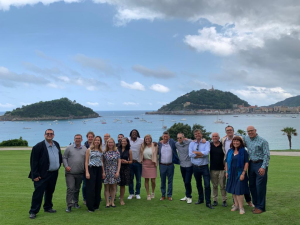Many of the things that happen to us seem to indicate that we’re entering a period characterized by a new asymmetry, by an imbalance that is especially difficult to understand and deal with.
This new zone of instability becomes evident in the phenomena of terrorism, violence and the new wars that may have ended the long period of stability of the national states, as configured by the Peace Treaty of Westphalia, that lasted until the end of the Cold War. Even the disarmament agreements at the time were instruments to maintain a symmetry that seemed to be advantageous for everyone.
Throughout that long period there have been, of course, many imbalances and not a few asymmetries (such as the colonial wars) but the world remained, at least in Europe, within a general framework of symmetry. I suggest we should follow this hypothesis and see if its development leads us to better understand the world in which we live.
A proper understanding of the sense of events allows us to make better forecasts and to face their complexity with greater efficacy. It could even give us some idea as to the evolution of the Iraqi resistance, if that is possible, and how to win the war on terrorism — because Bush doesn’t know what’s going on — or what could happen to other terrorisms closer to us.
All the differences between the old and new wars can be grouped, according to Herfried Münkler’s proposition, under the difference between symmetry and asymmetry. The classic wars between states were fundamentally symmetrical wars, during which an especially intense violence was waged on the battlefield. Attempts were made to contain such situations and keep them from spreading to wider spaces.
The classic war was symmetrical not because its actors enjoyed the same degree of strength but because they had the same rank: they were states. This equality of principle was the presumption that states acknowledged each other as similar and accepted the rules through which the law regulated — with greater or lesser success — the situations of peace and war.
The uniform was the symbol of that symmetry, because it distinguished some combatants from others and identified them as enemies. The ritualization of the cease-fire and the negotiations leading to a capitulation had the effect of facilitating the willingness to negotiate, so that it wouldn’t be necessary to proceed with a war whose outcome had been decided. It is not necessary to idealize these conditions to acknowledge their general validity, among other reasons because what is thus regulated remains an exercise of brutal violence.
The fact these things also have changed has become quite clear ever since the recent wars in Central Asia or in sub-Saharan Africa, and since the so-called international terrorism erupted among us. Most of the acts of violence that characterize the new wars, as measured by the international standards and treaties, are crimes of war. That is why wars often conclude with specific tribunals nowadays.
It can no longer be said that war is a confrontation between combatants, now that more than 80 percent of the dead are civilians, a figure that in the early 20th Century was about 10 percent. The new wars are characterized by a demilitarization of violence, as shown by the growing presence of paramilitary groups, the extension of the practice of kidnapping to civilians and the systematical application of sexual violence.
One of the characteristics of asymmetrical wars is that they lack proper battles but include massacres. Instead of decisive battles that might lead to capitulation and agreement, they feature a wholesale murder that leads to despair. Therein lies the central difference between symmetrical and asymmetrical wars. Part of the symmetrical nature of the traditional war is to end the combat in such a way that an escalation of violence will not ensue.
Massacres differ from battles by the fact that nothing is decided by massacres; they represent no advance in the direction of a peaceful close. On the contrary, they sharpen the desire for revenge and accelerate the infernal circle that increasingly harms the structures of society. The massacre is another step in an installed violence; the battle, at least in its intention, constitutes the beginning of the end of a war.
This difference leads to another, no less current, that allows us to understand the nature of our most entrenched conflicts. The classic wars were conceived as means to reach a conclusion; in the new wars, instead of peace accords we have peace processes involving not only two parties trying to reach the peace but also a third party who tries to motivate them to consider peace as something more attractive than war.
The symmetrical constellations are characterized as such because in them the ability to kill and be killed tends to be equally distributed. Asymmetry suppresses this balance radically: one party attempts to push the other into a position of utter inferiority, even defenselessness.
Where this asymmetry is best exemplified is in the imbalance represented by suicide attacks. And that’s because it is part of the symmetry of combat to assume that the enemy, although he may carry out acts that endanger his life, does not wish to die. Now then: whoever is not content with the normal risks of combat and chooses to die achieves a strategic advantage that turns him into an enemy who is very difficult to neutralize.
The behavior of a combatant who presumably does not wish to die in the attempt is calculable; a suicidal enemy introduces an incalculable imbalance, a radical asymmetry. As James Baldwin said: "The most dangerous creature in a society is the man who has nothing to lose."
Another feature of the asymmetrical wars is the tendency to consider the vanquished enemy as a trophy. This type of display represents the antithesis of the victor’s behavior towards the vanquished, as demanded (although almost never fully observed) by the traditional codes of war.
The humiliation and abusive treatment of the inmates at Abu Ghraib prison in Baghdad certainly shatter all rules of military law. But what’s most eloquent is that such acts were recorded in photographs. The fact that images exist means that in this case torture was not the only issue, although torture is both habitual and repugnant in a conflict of this nature.
For the American soldiers to document those forms of torture in photographs — while making such gestures — shows to what extent they have interiorized the asymmetrical logic of the trophy.
To make any predictions about the possible course of these conflicts, one has to consider another asymmetry, which deals with the resources needed to achieve victory. The side that enjoys military supremacy tries to reduce the duration of the war and the number of its casualties.
This urgency has to do with the fact that post-heroic societies are composed of individuals who find it difficult to justify in principle that a human life can be subordinated to a victory on the battlefield. In addition, their mentality finds the values of the warrior and the imperatives of survival increasingly strange. That is why the Americans have not shown their dead.
The less-developed societies, in turn, have a greater capacity for endurance. They can lengthen the war and thus attempt to win in the dimension of time, something their adversaries lack. To some, time is on their side; to others, against them. Only heroic societies are in a condition to sustain a guerrilla war.
Against the capacity for speed of a technologically superior enemy, the only thing heroic societies can do is to decelerate the course of the war. Unable to swing the war to their side through military means, they transform it into a process of attrition and weariness. The recent forms of terrorism are variations of such a strategy, turning inequality into an advantage.
The recent war in Iraq is a good example of this. The Americans hoped that the war they initiated with asymmetrical superiority could be ended with the model of a symmetrical war, that is, with a capitulation and a peace treaty.
Nothing could be more illusory. Following the Americans’ swift victory during the period of invasion, the nature of the war changed and the asymmetry of strength was replaced by the asymmetry of weakness.
This altered condition can be exemplified by the displacement of superiority regarding information. While the Americans were at first superior — their systems of advanced technology gave them complete control of the battlefield, while their enemies were blind and deaf in their hideouts — the situation changed the moment the invaders settled in-country and took over security and supplies.
From that time on, the soldiers who guarded buildings or means of transportation became easy targets for an enemy who emerged from clandestinity. From the beginning it was clear that the Iraqi resistance groups would never defeat the occupiers militarily; the only thing they could do was to inflict a number of casualties that the Americans could not politically absorb. What was decisive in this form of asymmetry was not the intensity of the war but its duration.
For a resistance guided by time-duration to succeed, it is essential that its enemies do not have an equal amount of time, that one side is more resilient than the other. While the nature of symmetrical wars was that the enemies had similar capacities regarding both intensity and duration, in asymmetrical wars both capacities develop in a different manner: one party is very able to apply force intensively, but only for a limited time. For the other party, the opposite is true.
The investment of time that, in a partisan war, could give victory to the combatants with technical inferiority can be made only in a society with a great capacity for suffering. Only heroic societies are capable of conducting a war under conditions of asymmetric weakness. Post-heroic societies will go to war only from a position of asymmetrical superiority that will minimize their own casualties and swing the war to their side in a brief period of time.
Ever since the end of the East-West conflict, the sophistication of the armaments held by the West has been not for the purpose of remaining in balance against a symmetrical enemy but to achieve the greatest possible superiority against heroic societies.
I am not completely sure that this analysis is correct, but I am sure that many political errors are made because people misunderstand what has to be solved. To thoroughly understand the terms of a problem is half of the solution. And, as it happens so often, the firmest and most resolute solutions are not always the best. Sometimes, firmness is greatest when the perplexity the political actors try to conceal is deepest.



